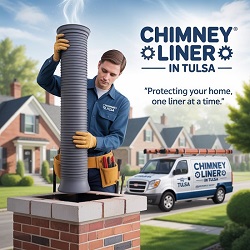


Learn the warning signs, costs, safety tips, and expert advice to protect your home and chimney system.
If your fireplace has lost its appeal or struggles to draft properly, it might be time to consider whether your chimney liner is past its prime. In Tulsa, where weather varies widely and older homes often come with aging masonry chimneys, liners can deteriorate quietly over time until something major goes wrong. Knowing when to get a new one can mean the difference between safe cozy evenings and hidden hazards. Discover the signs and practical steps—no guesswork needed—to decide if it’s time for a new Chimney Liner.
Chimney liners weaken over time due to smoke, moisture, heat, and chemical residue. Some common warning signs include persistent smoky odors inside the house, visible cracks during inspection, water stains near the chimney crown, or strange sounds when the chimney heats up. If your fire doesn’t burn cleanly, or you see sparks coming out of the flue, those are strong hints something inside is wrong.
You can’t rely on guesswork or visual cues from the outside. A certified chimney sweep or inspector uses high-definition cameras and airflow testing to look inside the flue. They’ll check for cracked clay tiles, corroded metal liners, blockages, creosote buildup, or misalignment. In Tulsa, monthly temperature swings and humidity cycles can accelerate liner breakdown, so inspections help you catch early-stage damage.
|
Service Type |
Estimated Cost Range |
|
Basic Inspection |
$100 – $250 |
|
Clay Tile Liner Replacement |
$1,800 – $3,200+ |
|
Stainless Steel Liner Install |
$2,300 – $4,000+ |
|
Minor Repair & Seal |
$700 – $1,500 |
|
Annual Cleaning |
$150 – $300 |
Note: These Tulsa-based estimates vary by chimney length, liner type, ease of access, and labor rates. Always request a written quote.
Safety is the top reason to consider replacing an old liner. Even a small crack can let carbon monoxide escape or let heat ignite nearby combustible materials. From a cost standpoint, upgrading to a stainless steel liner may cost more up front but can save you money over time with better durability and easier cleaning. Clay tile liners can last decades if well cared for, but repairs get more expensive if left too long. Getting a liner replaced before winter also avoids emergency service costs and peace-of-mind savings—knowing your fireplace is safe and reliable.
“Many Tulsa homeowners wait until the smell of smoke or backdraft becomes too obvious. An annual inspection often spots liner damage well before it becomes hazardous or expensive to fix.” — Heather Collins, CSA‑Certified Chimney Expert, Tulsa
Q: Can a chimney liner fail without visible signs?
A: Yes. Internal cracks, separation or shrinkage may not be visible from the top or bottom, so only a proper inspection can reveal hidden issues.
Q: How long does a chimney liner last?
A: Clay tile liners can last 50+ years if maintained. Stainless steel liners generally last 15–25 years depending on usage.
Q: Is it legal to use a faulty chimney without replacing the liner?
A: Most building codes require a functioning liner. Using one that’s cracked or missing may violate local codes and insurance standards.
Q: Can I repair a damaged liner instead of replacing it?
A: Minor repairs like sealing small gaps might work short-term, but major cracks or misalignment usually require full replacement for safety.
Q: Will insurance cover a chimney liner replacement?
A: Only if damage was caused by a covered event, such as a chimney fire. General wear or age-related issues are typically excluded.
Knowing when to replace your chimney liner in Tulsa comes down to watching for warning signs, getting annual inspections, and balancing safety with cost. An aging or damaged liner may not draw proper exhaust, risking safety and reducing efficiency. Investing in a new liner—especially a stainless steel option—may feel expensive initially, but it pays off with better performance, lower maintenance, and greater home fire protection. If you haven’t had your liner checked in a few years or have noted symptoms like smoke, odors, or cracks, now’s the time to schedule an inspection. Keep your home safe and your fires enjoyable with a reliable, well-maintained Chimney Liner.
Read More: Chimney Sweep
